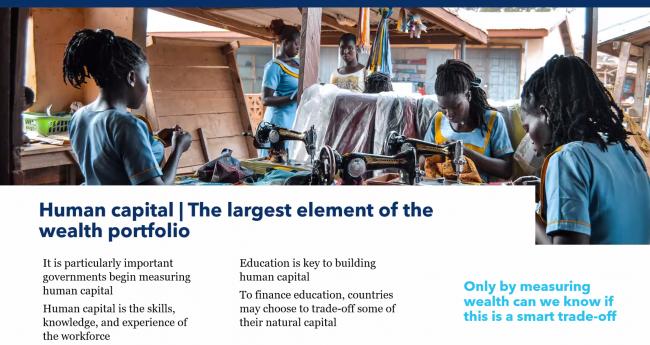This event introduced examples of expanded wealth measures and demonstrated the ways in which they can be used to prioritize post-COVID recovery investments and better capture progress towards achievement of the SDGs.
The International Institute for Sustainable Development (IISD) organized the event, “Building Post-COVID Recovery Around Wealth rather than GDP,” on 12 July, 2021. It was attended by 149 participants.
The moderator, Dominique Charron, International Development Research Centre (IDRC), highlighted the need to consolidate efforts to go “beyond GDP” to address gaps in development, especially from the standpoint of sustainability and inclusion. She noted GDP is insufficient to measure achievement of the SDGs and may risk exacerbating national and global challenges through short-term rather than long-term decision making. Given the ongoing economic challenges of the pandemic, she stressed the importance of inclusive wealth measures to “get back on track” in progressing towards the SDGs.
Robert Smith, IISD, distinguished wealth from income, stressing that wealth refers to skills and assets that are owned and used as the basis to generate income. He noted that wealth, rather than income flows alone, should be used to measure the resilience and sustainability of well-being. Smith highlighted how wealth derives from various forms of capital, focusing on two types: human and produced capital. He stressed the need to measure inclusive wealth, as “governments do not pay enough attention to the long-term.” He concluded that only by measuring wealth will target investments in infrastructure to generate long-term resilience be possible.
Pushpam Kumar, UN Environment Programme (UNEP), presented on the importance of natural capital in achieving a “green recovery” from the pandemic. Noting more than 30% of new zoonotic diseases since 1960 have emerged as a result of land-use change, he stressed that pandemics serve as early warning of the need to judiciously manage natural capital. To achieve this goal, he said natural capital requires better accounting systems to ensure its inclusion in economic wealth measurement and pointed to Pakistan’s recent efforts to measure inclusive wealth. In conclusion, Kumar stressed that ecological, human health, and economic recovery cannot be viewed in isolation. He also mentioned how natural capital accounting can synergize with other sustainable development frameworks, including the circular economy model, nature-based solutions, and land degradation neutrality.
Matthew Agarwala, University of Cambridge, underscored that social capital “impacts and pervades everything we do” and is, therefore, crucial for all economic outcomes. Describing social capital as “the ability of communities to overcome collective action problems,” he regretted that it is easy to understand but difficult to measure. He highlighted individual and collective elements of social capital, such as personal relationships, degree of trust in others, quality of networks, and shared sense of community. Underlining social capital’s relationship to key economic outcomes, he pointed to savings in defensive expenditures, reduced transaction costs, and enhanced cooperation. He stressed that though social capital measures are imperfect, they can, nevertheless, be used to build conclusions about how we organize our economy.
Alin Halimatussadiah, Universitas Indonesia, explained how the pandemic has decreased capital in Indonesia. Noting the country’s heavy reliance on coal and palm oil commodities for export, she said reduced investment had decreased productivity in the industrial sector. She observed that the pandemic contributed to a 1% increase in the poverty rate, as well as an increase in inequality. Stressing that informal workers have been disproportionately impacted, she predicted that the pandemic could worsen inequality in asset holding and hinder Indonesia’s shift to industrialization. Halimatussadiah suggested prioritizing investments, giving more consideration to the complementarity among different capital types, and avoiding trade-offs between capital would mitigate the pandemic’s negative effects. She concluded by highlighting Indonesia’s challenges in constructing expanded wealth indicators, including its lack of disaggregated data, estimates of depreciation rate by capital type, and comparable indicators of social capital.
Following the panel presentation, panelists discussed questions from the audience on: linkages between inequality and natural capital; ways to increase uptake of comprehensive wealth measures; the importance of taking a long-term view on human and natural capital in Indonesia; and the challenges of governing trade-offs between various forms of capital.










